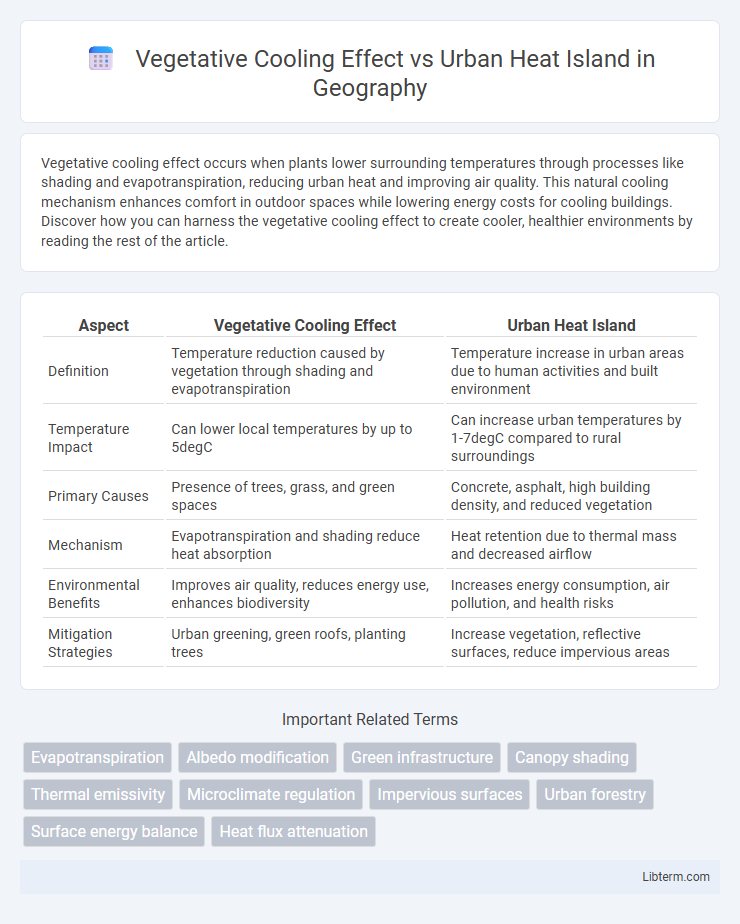Vegetative cooling effect occurs when plants lower surrounding temperatures through processes like shading and evapotranspiration, reducing urban heat and improving air quality. This natural cooling mechanism enhances comfort in outdoor spaces while lowering energy costs for cooling buildings. Discover how you can harness the vegetative cooling effect to create cooler, healthier environments by reading the rest of the article.
Table of Comparison
| Aspect | Vegetative Cooling Effect | Urban Heat Island |
|---|---|---|
| Definition | Temperature reduction caused by vegetation through shading and evapotranspiration | Temperature increase in urban areas due to human activities and built environment |
| Temperature Impact | Can lower local temperatures by up to 5degC | Can increase urban temperatures by 1-7degC compared to rural surroundings |
| Primary Causes | Presence of trees, grass, and green spaces | Concrete, asphalt, high building density, and reduced vegetation |
| Mechanism | Evapotranspiration and shading reduce heat absorption | Heat retention due to thermal mass and decreased airflow |
| Environmental Benefits | Improves air quality, reduces energy use, enhances biodiversity | Increases energy consumption, air pollution, and health risks |
| Mitigation Strategies | Urban greening, green roofs, planting trees | Increase vegetation, reflective surfaces, reduce impervious areas |
Understanding Vegetative Cooling Effect
Vegetative cooling effect significantly reduces surface and air temperatures by enhancing evapotranspiration and providing shade, which directly counteracts the urban heat island phenomenon. Trees, green roofs, and urban vegetation increase albedo and improve microclimates, leading to lower heat retention in urban areas compared to concrete and asphalt surfaces. This natural cooling process is essential for mitigating extreme heat, improving urban livability, and reducing energy consumption for cooling systems.
What Is Urban Heat Island?
Urban Heat Island (UHI) is a metropolitan area significantly warmer than its surrounding rural areas due to human activities and infrastructure like buildings, roads, and pavement that absorb and retain heat. Vegetative cooling effect mitigates UHI by providing shade, increasing evapotranspiration, and reducing surface temperatures through plant cover. Studies show urban parks can be 1-7degC cooler, directly counteracting UHI impacts on energy consumption and public health.
Mechanisms Behind Vegetative Cooling
Vegetative cooling mitigates the Urban Heat Island (UHI) effect primarily through evapotranspiration, where plants release water vapor that cools the air by absorbing heat. Vegetation's canopy also provides shade, reducing surface temperatures by limiting solar radiation absorption on urban materials. Furthermore, greenery enhances albedo by reflecting more sunlight compared to dark, impervious urban surfaces, collectively lowering ambient temperatures and counteracting UHI intensities.
Causes of Urban Heat Island Formation
Urban Heat Island (UHI) formation is primarily caused by the replacement of natural vegetation with impervious surfaces such as asphalt, concrete, and buildings that absorb and retain heat. Reduced evapotranspiration due to the loss of green spaces limits the natural cooling effect provided by plants, raising urban temperatures. High-energy consumption from vehicles and industries further intensifies heat accumulation, exacerbating temperature differences between urban and rural areas.
Vegetation’s Role in Temperature Regulation
Vegetative cooling significantly reduces surface and air temperatures by providing shade, increasing evapotranspiration, and enhancing albedo in urban areas, effectively combating the Urban Heat Island (UHI) effect. Trees and green spaces can lower ambient temperatures by up to 5degC in densely built environments, improving thermal comfort and reducing energy consumption for cooling. Integrating urban vegetation into city planning supports sustainable temperature regulation and mitigates the detrimental impacts of UHI on public health and infrastructure.
Comparative Impact on Urban Microclimate
Vegetative cooling significantly reduces urban heat island intensity by enhancing evapotranspiration and providing shade, which lowers surface and air temperatures by up to 5degC in dense green spaces. Urban heat islands, conversely, increase temperatures through heat absorption by impervious surfaces, elevating local microclimates by 2-7degC compared to rural areas. Incorporating strategic vegetation can mitigate heat buildup and improve urban microclimate resilience, highlighting a crucial interplay in sustainable city design.
Benefits of Vegetative Cooling in Cities
Vegetative cooling significantly reduces urban heat island (UHI) effects by lowering surface and air temperatures through shade provision and evapotranspiration. Trees and green spaces improve urban microclimates, enhancing thermal comfort and reducing energy demand for air conditioning. Increased vegetation also supports air quality improvement and stormwater management, promoting healthier, more resilient cities.
Challenges of Mitigating Urban Heat Island
Mitigating urban heat island (UHI) effects faces challenges including limited vegetation cover in densely built environments, which reduces the effectiveness of vegetative cooling through evapotranspiration. Urban materials such as concrete and asphalt have high thermal mass and low albedo, absorbing and retaining heat that counters natural cooling processes. Moreover, restricted space and competing land uses hamper large-scale implementation of green infrastructure critical for substantial temperature reductions.
Integrating Green Infrastructure Solutions
Integrating green infrastructure solutions, such as green roofs, urban forests, and permeable pavements, significantly enhances vegetative cooling effects to counteract Urban Heat Island (UHI) impacts. These natural elements increase evapotranspiration and provide shade, reducing ambient temperatures in densely built environments by up to 5degC. Strategic urban planning that prioritizes vegetation connectivity and diversity maximizes thermal regulation, improves air quality, and promotes sustainable microclimates essential for mitigating UHI challenges.
Future Trends in Urban Climate Adaptation
Vegetative cooling significantly mitigates the Urban Heat Island (UHI) effect by reducing surface temperatures through evapotranspiration and shade provision, essential for future urban climate adaptation strategies. Innovations in green infrastructure, such as vertical gardens and green roofs integrated with AI-driven monitoring systems, are projected to enhance cooling efficiency and energy savings in cities. Climate models predict increased adoption of tree-lined streets and urban parks to counteract rising temperatures, supporting sustainable urban resilience against intensified heatwaves.
Vegetative Cooling Effect Infographic

 libterm.com
libterm.com